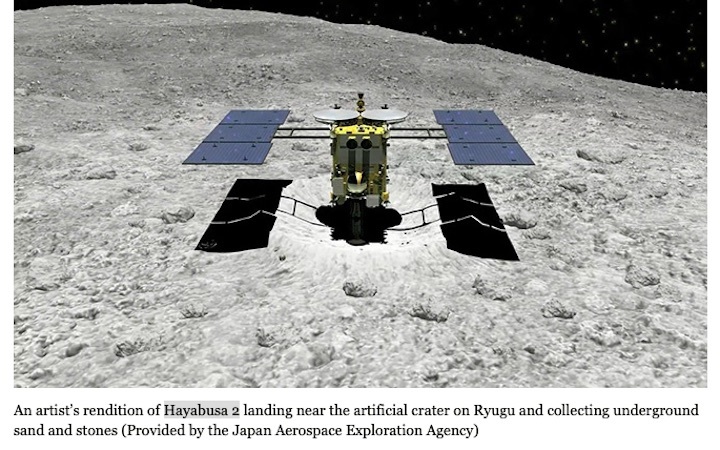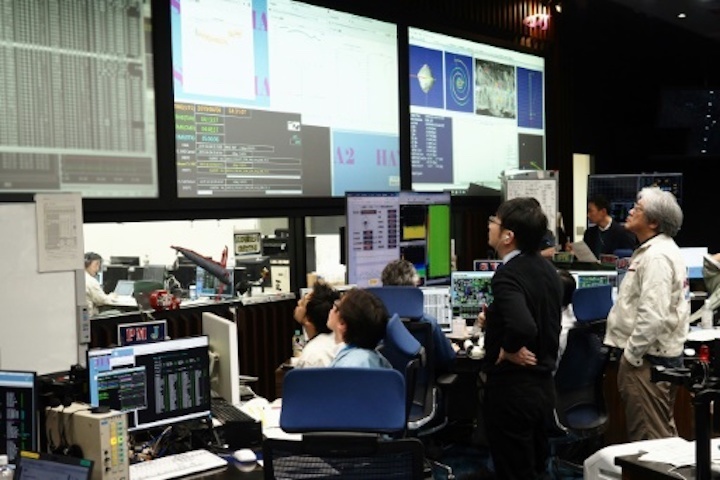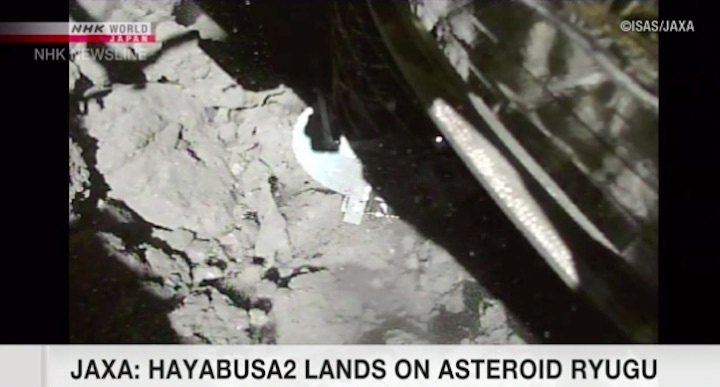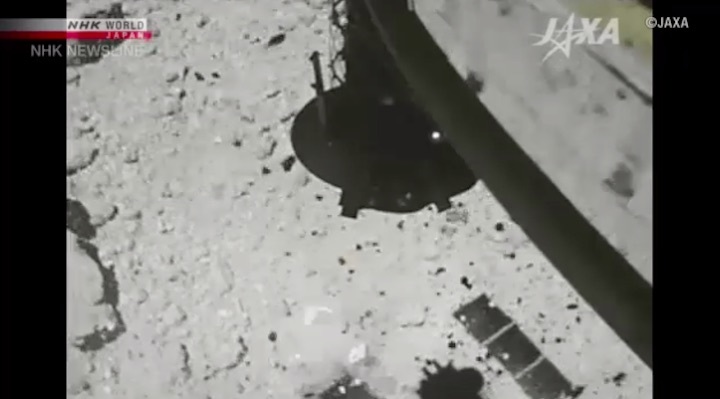Japan's space agency, JAXA, has released three photos taken by the space probe Hayabusa2 during its landing on the asteroid Ryugu in its unprecedented mission to collect underground samples.
One of the photos released on Thursday, taken 4 seconds before touchdown, is a close-up of the asteroid's rocky surface.
The second photo was taken at the moment of touchdown, as a cylindrical sample collector on the probe reached the surface. The image is partially blurred, apparently due to a cloud of sand dust stirred up on impact.
The third photo was taken 4 seconds later, immediately after the sample collector fired a bullet into the surface to collect rock samples. The photo shows countless shattered rocks flying around.
Professor Seiichiro Watanabe of Nagoya University is a senior member of the JAXA project team.
He said the images indicate that a sand deposit was created on the surface after Hayabusa2 formed a crater on Ryugu in April.
Watanabe said this means the collector very likely gathered samples from inside the asteroid.
Quelle: NHK
+++
Japan's Hayabusa2 probe lands on asteroid Ryugu for 2nd time
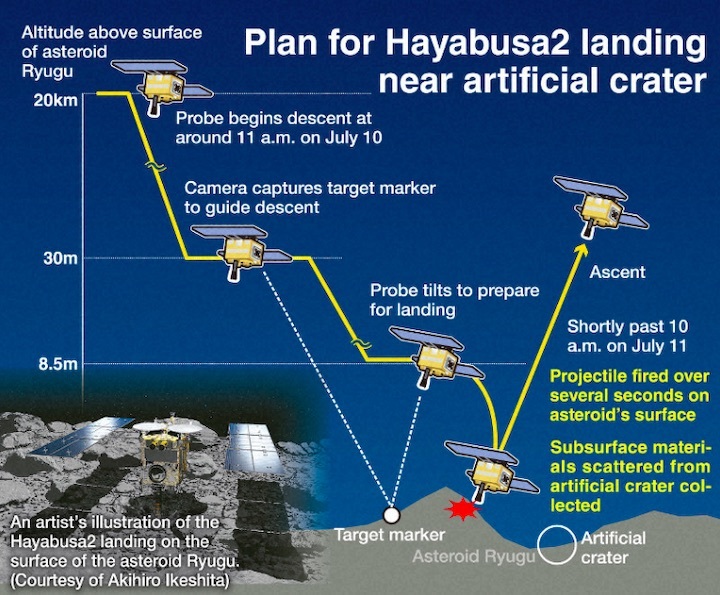
TOKYO -- The Japanese space probe Hayabusa2 successfully touched down on the asteroid Ryugu for the second time on July 11, the Japan Aerospace Exploration Agency (JAXA) announced.
JAXA said on the morning of July 11 it had confirmed the space probe started ascending following its descent toward the asteroid that began the previous day. If it successfully collected materials from below the surface of an artificial crater that it made on the asteroid, it would mark the first time in history for a space agency to accomplish such a feat.
The touchdown brought to completion a key mission for the space probe that reached Ryugu, currently located some 250 million kilometers from Earth, on June 27 last year. The probe is scheduled to return to Earth at the end of 2020 after leaving the asteroid sometime between November and December 2019.
Hayabusa2 began to descend toward Ryugu from an altitude of 20 kilometers on July 10, and JAXA judged the following morning that the touchdown was successful.
When it reached an altitude of 30 meters above the surface of the asteroid, Hayabusa2 switched to full autonomous function, using a camera to track a target marker that it had dropped earlier on the surface to guide its descent. The probe is believed to have aimed to land 2.6 meters away from the target marker.
Workers at the JAXA Institute of Space and Astronautical Science in Chuo Ward in the city of Sagamihara in the eastern Japan prefecture of Kanagawa observed changes in radio waves sent from the probe during its descent. When they confirmed that it was rising again, they erupted in applause with smiles on their faces.
Under the touchdown operation plans, the probe was supposed to rise from Ryugu immediately after a cylinder-shaped protrusion on the bottom of the probe came into contact with the surface.
When Hayabusa2 first successfully touched down on Ryugu in February this year, particles that flew up clouded the camera and an altimeter, decreasing their sensitivity. Because of this, the JAXA team lowered the altitude at which full autonomous function would begin from 45 meters during the first touchdown to 30 meters this time, making it possible to find the target marker with a higher degree of certainty and measure its altitude. Hayabusa's field of view becomes narrower when it switches to autonomous function.
Quelle: The Mainichi
----
Update: 12.07.2019
.
Probe lands on asteroid; JAXA awaits data on sample collection
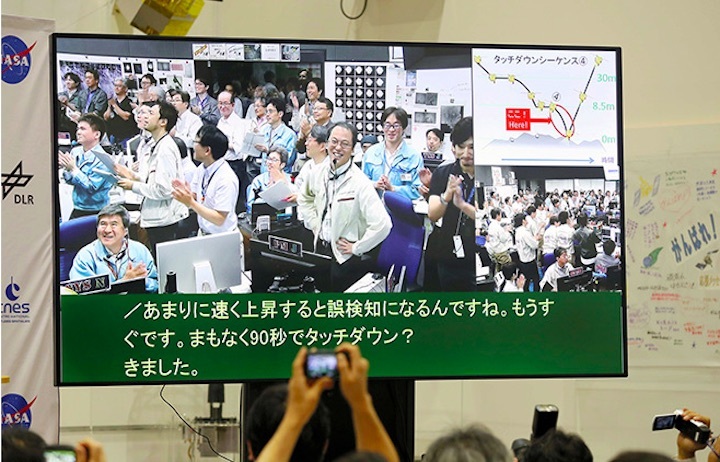
A press room monitor shows applause breaking out in the control room of the Sagamihara complex of the Japan Aerospace Exploration Agency on July 11 after confirmation was received that the Hayabusa 2 space probe made a second landing on the asteroid Ryugu. (Ryo Ikeda)
The Hayabusa 2 space probe has landed on the asteroid Ryugu, but scientists were still waiting to see if it collected underground samples that could provide clues on how the solar system was created.
Officials of the Japan Aerospace Exploration Agency (JAXA) announced around 11 a.m. on July 11 that they had received data confirming Hayabusa 2 made its second landing on the asteroid about 240 million kilometers from Earth.
After it descended to about 300 meters above Ryugu, the probe was no longer under the control of JAXA scientists. It made the final descent based on information gathered from equipment on-board.
JAXA officials said they had also observed signals indicating the probe had risen from the surface as planned. But final confirmation will take more time because data sent by Hayabusa 2 reaches Earth in about 13 and a half minutes.
The probe first landed on Ryugu in February and is believed to have collect samples of surface sand and rocks. In April, Hayabusa 2 dropped an explosive on the asteroid to create an artificial crater.
The second landing near that crater is intended to collect what JAXA hopes are the world’s first underground samples from an asteroid. JAXA scientists had also confirmed that the probe fired a bullet into the surface to kick up sand and rocks for collection by the probe.
“The probe worked so perfectly that it felt like a rehearsal,” Takashi Kubota, a JAXA senior project member, said about the day's developments.
If the second collection is successful, Hayabusa 2 will have far surpassed its predecessor, but it still faces the difficult task of returning to Earth in as intact a condition as possible.
Some within JAXA had suggested aborting the second landing and having the probe return to Earth with the samples collected from the first landing.
There were concerns about the risk of losing the surface samples if the probe was damaged on the second landing, making its return to Earth more difficult.
Hayabusa 1 was damaged when it landed on another asteroid, the Itokawa, in 2005.
But JAXA scientists learned from that first mission and conducted numerous simulations using the successor probe. They were confident that a second landing could be pulled off.
The second landing was about the last chance for Hayabusa 2 because surface temperatures on Ryugu were increasing as the asteroid’s orbit was bringing it closer to the sun.
Plans call for Hayabusa 2 to leave Ryugu by the end of this year and return to Earth toward the end of 2020.
Ryugu has a diameter of about 900 meters and is believed to contain more carbon than the Itokawa asteroid, leaving open the possibility that Ryugu holds organic substances.
Most asteroids have an orbit that is outside that of Mars. But Ryugu has a rare orbit that periodically brings it closer to Earth, making it easier to observe.
At the same time, it is classified as a potentially dangerous asteroid because of the possibility that it could collide with Earth.
Quelle: The Asahi Shimbun
+++
JAXA:
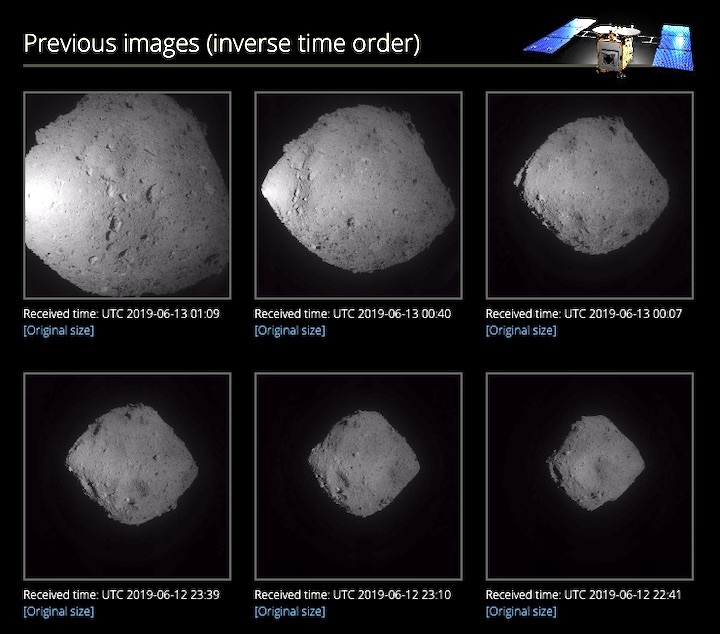
Approach to the 2nd touchdown –Part 1:
observations near the touchdown point–
Our first touchdown took place this year on February 22. Then as a new challenge for the Hayabusa2 Project, we succeeded in creating an artificial crater using the Small Carry-on Impactor (SCI) on April 5. The last big operation left at asteroid Ryugu is the collection of subsurface material exposed with the creation of the artificial crater. In order to collect this material, we need a second touchdown for which the project has been steadily preparing. At this point, it has not yet been decided whether or not to go ahead with a second touchdown, but here we will introduce our preparations in the “Approach to the second touchdown”.
After the operation to form the artificial crater, the spacecraft descended a total of four times above or near the crater site. These descent operations allowed us to obtain detailed data of the region near the artificial crater. In addition, we succeeded in dropping a target marker in the area close to the artificial crater on May 30. Combined, these operations mean that the situation around the artificial crater is now well understood.
Figure 1 shows an image taken during the low altitude descent observation operation (PPTD-TM1B) conducted from June 11 – 13. The target marker was captured in the image and you can get a handle on the state of the surface.
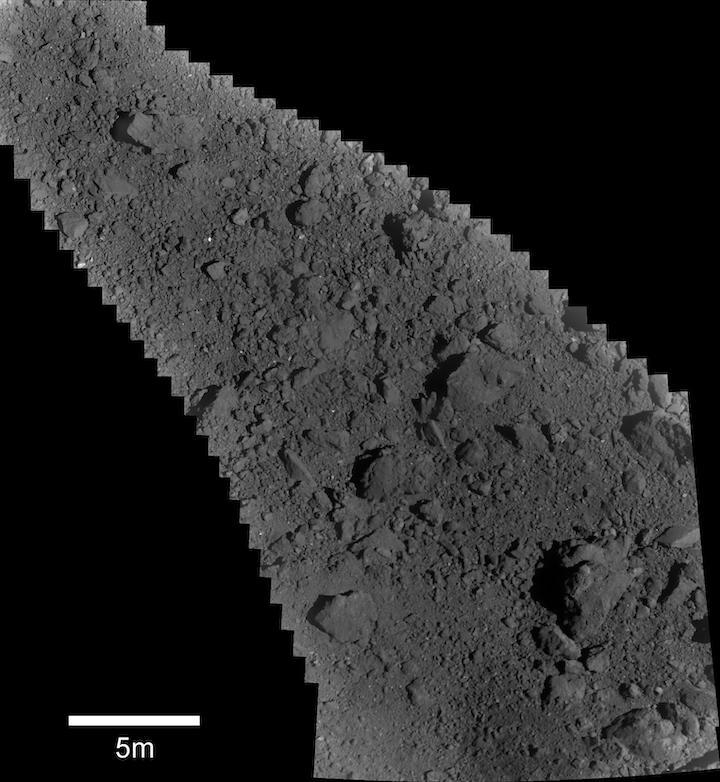
"JAXA, Chiba Institute of Technology & collaborators".
- Figure 1: Image taken on June 13, 2019 during the operation PPTD-TM1B. This is a composite of 28 images taken at 7 second intervals starting from 10:58 JST (upper left) to 11:01 (lower right) using the Optical Navigation Camera – Telescopic (ONC-T). The image altitude is about 52m at the start and 108m at the end. The white point in the upper-left center is the target marker. You can see that detailed images have been acquired continuously from the target marker to the edge of the artificial crater, located in the lower-right of the image. (Image credit ※: JAXA, Chiba Institute of Technology, University of Tokyo, Kochi University, Rikkyo University, Nagoya University, Meiji University, University of Aizu, AIST.)
As you can see in Figure 1, asteroid Ryugu is covered with boulders. If we go for a second touchdown, we need to aim for a point close to the target marker which has no obstacles. The project is currently examining this area in detail.
+++
Approach to the 2nd touchdown –Part 2:
details of the touchdown point–
n ‘Part 1’ of this article on June 19, we looked at images from observations of the asteroid surface near the planned site for the second touchdown to collect a sample. In this article, we examine the details of the touchdown site.
First, let’s recall the separation of the target marker. On May 30, 2019, one of Hayabusa2’s target markers was successfully dropped during the PPTD-TM1A operation (figures 1- 6 from our press briefing in June ).
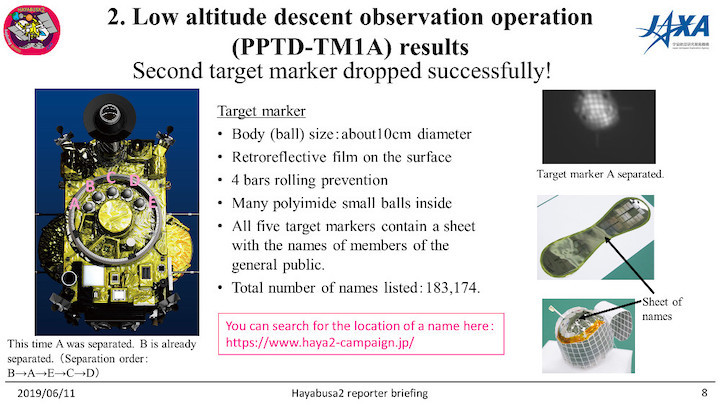
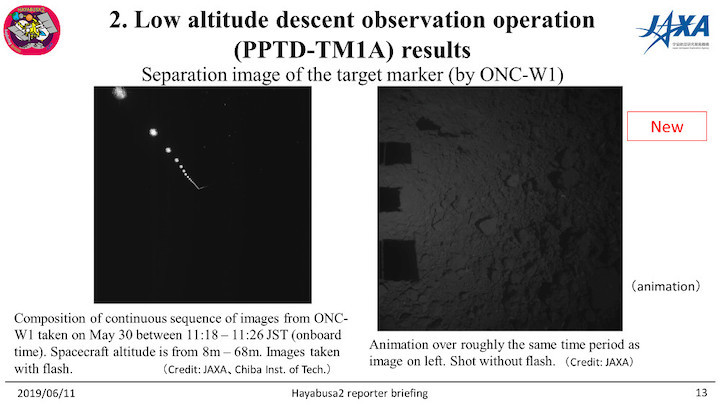
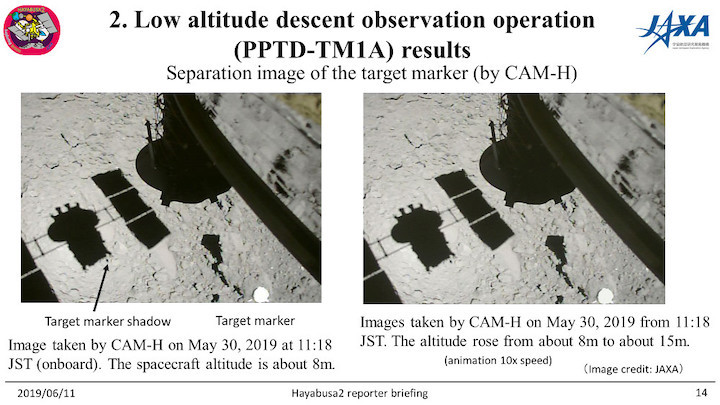
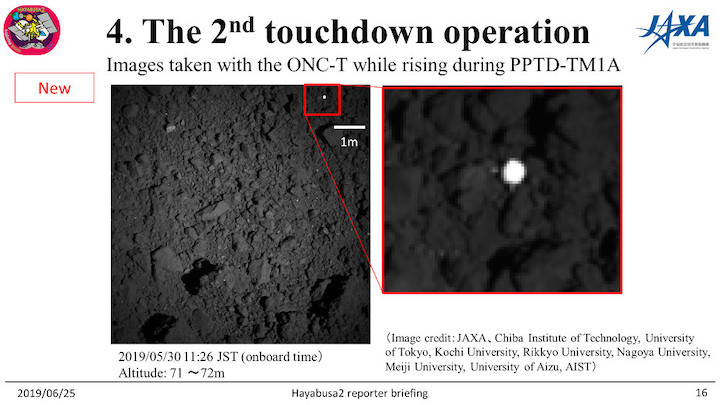
- Figure 6: Image of the target marker on the surface of Ryugu after landing (2019/6/25 press briefing material). Taken on May 30, 2019 (credit ※1: JAXA, Chiba Institute of Technology, University of Tokyo, Kochi University, Rikkyo University, Nagoya University, Meiji University, University of Aizu, AIST).
Figure 7 shows a comparison with the first target marker drop (TD1-R3 operation, 2018/10/25). In TD1-R3, the position error (distance from the target drop point) was 15m. This was reduced to 3m for the second target marker dropped during PPTD-TM1A.

- Figure 7: Comparison between the two target marker drop operations (2019/6/11 press briefing material). (Credit ※2: JAXA, University of Tokyo, Kochi University, Rikkyo University, Nagoya University, Chiba Institute of Technology, Meiji University, University of Aizu, AIST).
Once the target marker was successfully dropped, the project team proceeded with a detailed examination of the potential touchdown points close to where the target marker now lay.
In Figure 8, we can see area C01-Cb, which is a region modified from the earlier identified region, C01-C.
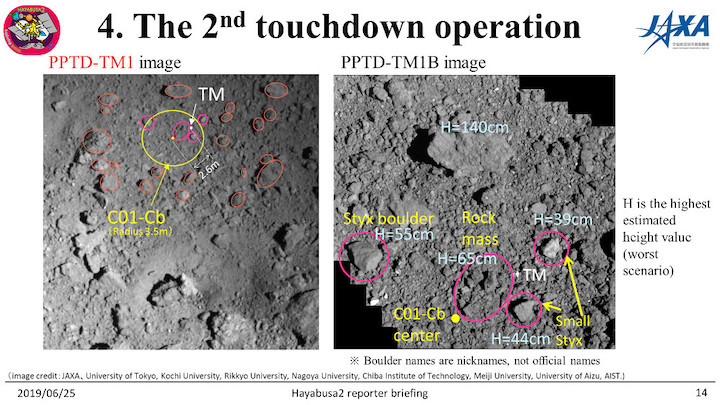
- Figure 8: The area C01-Cb where touchdown is planned (from the 2019.6.25 press briefing material). [Left] The area surrounding C01-Cb, captured by the Optical Navigation Camera – Telescopic (ONC-T), taken on May 16 (before the target marker was dropped). [Right] A mosaic of multiple images taken on June 13 with the ONC-T. (Credit ※2: JAXA, University of Tokyo. Kochi University, Rikkyo University, Nagoya University, Chiba Institute of Technology, Meiji University, University of Aizu, AIST.)
The left-hand image in Figure 8 shows the area surrounding C01-Cb, which includes the artificial crater generated with the SCI. The background to this image is the same as the right-hand image in Figure 6, but differently annotated. The red ovals indicate the location of large rocks that pose a danger to the spacecraft. On the right of Figure 8, you can see a high resolution image close to where the target marker landed. The rocks indicated by the pink ovals were examined particularly carefully by the team for potential danger to the spacecraft, and the numbers alongside these in light blue are the estimated height of the rock. These interesting rocks have been given names, although these are just nicknames used for this study and not official names approved by the IAU. The names “Styx” and “small Styx” come from the name of the River Styx; the river that forms the boundary between life and death in Greek mythology. The “rock mass” is, as the name suggests, a place where several rocks have piled up.
In addition to these high resolution images, digital topographic maps of the area were created using the observational data obtained during the previous descent observation operations. Figure 9 shows this digital topographic map.
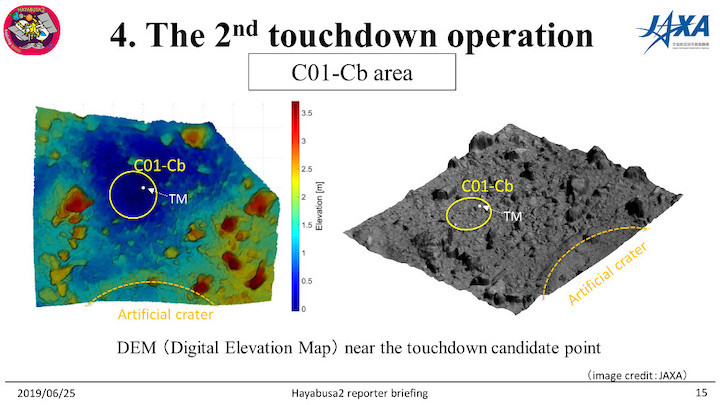
- Figure 9: Digital topographic map near the C01-Cb area (from the 2019/6/25 press briefing materials). (Credit ※:JAXA)
The C01-Cb region was selected for the site of the second touchdown on the basis of this detailed study. Details on the decision for the touchdown itself will be covered in another article.
The second touchdown is planned for July 11.
Thank you for all your support!
Hayabusa2 Project
Quelle: JAXA

